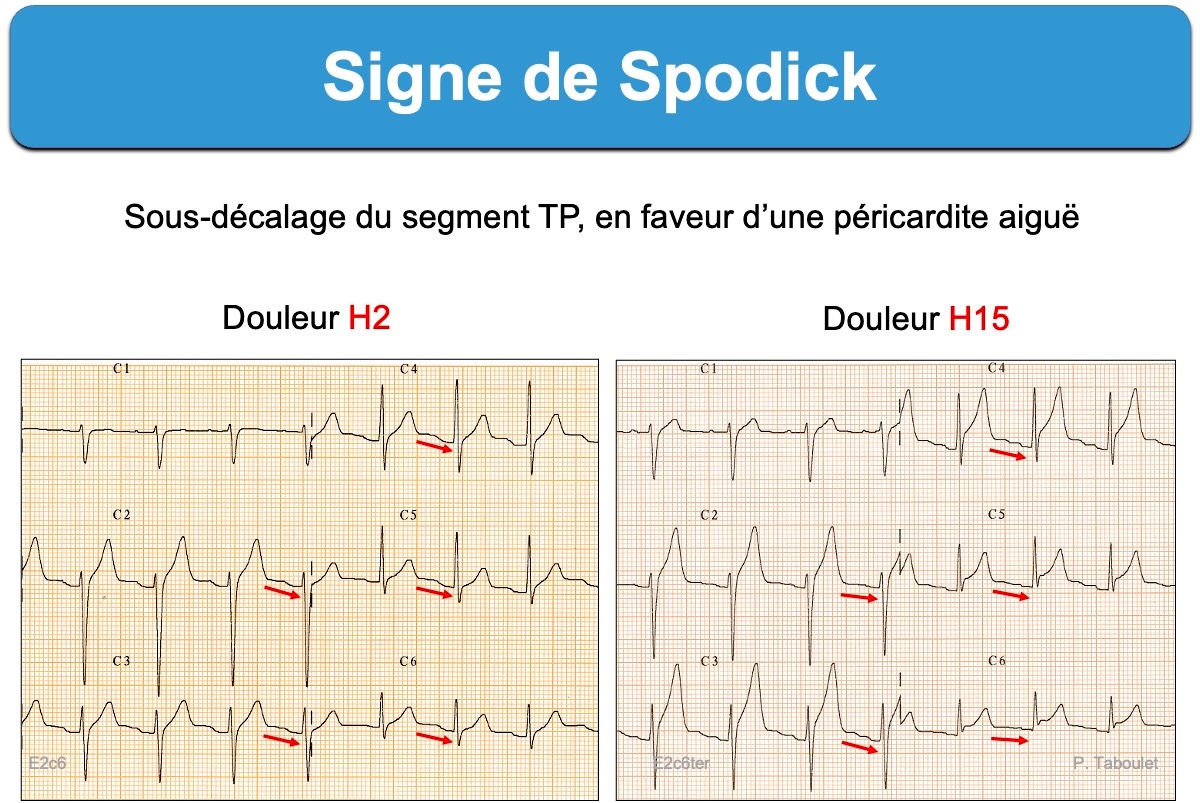Sous-décalage descendant du segment TP en faveur d’une péricardite aiguë avec sus-décalage de ST à son début.
C’est un signe précoce mais peu sensible qui accompagne parfois le sus-décalage du segment ST et les ondes T amples, souvent associé aussi au sous-décalage de PQ [1][2].
Il peut aider au diagnostic différentiel de la PA avec un infarctus ST+ [3]

[1] Abdelazeem B, Kandah E, Borcheni M, Alnaimat S, Kunadi A. Spodick’s Sign: A Case Report and Review of Literature. Cureus. 2020 Nov 21;12(11):e11606. (téléchargeable)
We present a case of a 52-year-old male who initially presented with acute onset substernal chest pain. His EKG revealed diffuse subtle ST elevation and downsloping TP segment (Spodick’s sign).
[2] Chaubey VK, Chhabra L. Spodick’s sign: a helpful electrocardiographic clue to the diagnosis of acute pericarditis. Perm J. 2014 Winter;18(1):e122. (téléchargeable)
It signifies to a downsloping TP segment in patients with acute pericarditis and is present in about 80% of the patients affected with acute pericarditis (pas du tout ma statistique, je crois qu’il confond avec 82% de sous décalage de PR cité dans la publi de Spodick 1973)
The sign is often best visualized in lead II and lateral precordial leads. In addition, Spodick’s sign may also serve as an important distinguishing electrocardiographic tool between the acute pericarditis and acute coronary syndrome.3 PR-segment depression when used alone can sometimes be a masquerader, as it can be seen in both acute pericarditis and acute coronary syndrome. However, the presence of PR depression and Spodick’s sign is often a giveaway to the diagnosis
[3] Witting MD, Hu KM, Westreich AA, Tewelde S, Farzad A, Mattu A. Evaluation of Spodick’s Sign and Other Electrocardiographic Findings as Indicators of STEMI and Pericarditis. J Emerg Med. 2020 Apr;58(4):562-569.
Spodick’s sign occurred in 5% of patients with STEMI (95% CI 3-10%) and 29% of patients with pericarditis (95% CI 16-45%). All other findings statistically distinguished STEMI from pericarditis, but ST depression (OR 31), III > II (OR 21), and absence of PR depression (OR 12) had the greatest OR values.
